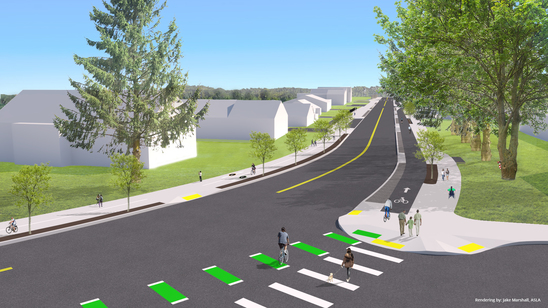 The Portland Bureau of Transportation (PBOT), Bureau of
Environmental Services (BES) and Portland Water Bureau (PWB) have completed the
latest set of engineering plans for the SW Capitol Highway: Multnomah Village –
West Portland project between Garden Home and Taylors Ferry Roads. The 60% plans represent the second of four iteratively
developed engineering plan sets for the project, preceded by the 30% plans
released last January, and followed by 90% and final plans early next year. Construction
is scheduled to begin in summer 2019.
Water Bureau joins
project
We are excited to welcome the Portland Water Bureau to the project. PWB
is coordinating water main, fire hydrant and regulator upgrades in concert with
the transportation and stormwater improvements to help avoid additional
construction disruptions. Crews will install 3,735 feet of new ductile iron
water main pipes, move nine fire hydrants, relocate 75 existing services, and modify
the access for one existing water main regulator. Most of the cast iron pipe
being replaced was installed in 1961 and is now 57 years old. Ductile iron
pipes are three times less likely to fail during a seismic event than cast
iron. The new pipes also will be larger to help meet current and future capacity
needs. Fire hydrants and existing services will be relocated to accommodate the
new curb lines, retaining walls, and other project improvements. PWB was able
to quickly catch up to the 60% design level so that all three bureaus are included
in consolidated design and construction packages moving forward.
Green streets
removed, side street improvements added
The most significant change in the 60% design is the removal
of “green street” planters from the Capitol Highway corridor itself. This
allows for more separation between people walking and biking on the east
(downhill) side of the roadway, and reduced grading impacts on the west side.
Stormwater runoff will be directed into storm drains and piped to regional stormwater
detention facilities on SW 42nd Avenue south of Alice Street, SW Dolph Court
east of Capitol Highway, and SW Multnomah Blvd west of 40th Avenue, for
treatment and storage before water is discharged into local streams. Some
limited street improvements will be constructed along with these regional
facilities, including a short stretch of sidewalk on SW Dolph Court, and asphalt
paving on SW 42nd Avenue and Alice Street.
Retaining walls
refined
The 30% plans showed tentative locations where retaining
walls may be necessary. In the 60% plans, the location, height, width and type
of retaining walls are more certain, and initial wall design sheets have been
drafted. Retaining walls are needed where the project is either cutting into
the existing ground (“cut walls”) or filling on top of the ground (“fill walls”).
Stabilizing these areas allows the project to build sidewalks with lesser
impact to adjacent properties. Most retaining walls in the current design are
three to five feet tall. Due to site topography, taller walls (up to eight feet
high) are necessary in two locations: between Alice and Primrose Streets, and
between Lobelia Street and Dolph Court.
The project will include three types of retaining walls:
gravity block walls, keystone block walls, and cast-in-place concrete walls. Gravity blocks are large, interlocking,
stacked blocks. They are generally less expensive than other wall types but
require wider excavation as height increases. Keystone blocks are smaller blocks ideal for small grade changes
and are similar to products you might see at a home improvement store. Cast-in-place walls are a good solution
for taller walls and offer more opportunity for aesthetic treatments but are
nearly twice as expensive as gravity blocks. Each wall type will be used in the
project, applied to the situation most suitable.
Railings also will also be necessary, including along the
back of elevated sidewalks and along some front yards that will have steep
drop-offs. At a May 2018 meeting, Capitol Highway Subcommittee members generally
preferred the aesthetic qualities of cast-in-place walls and black-painted
ornamental railings. Project staff will consider these preferences along with
technical and cost considerations as the wall and railing designs advance.
Signing and striping
added
The 60% plans include the first design iteration of the signs,
stripes and markings needed to define roadway uses and spaces. Highlights
include the use of black methyl methacrylate (MMA) to differentiate the
protected bike lane from the lighter concrete sidewalk on the east side of the
roadway, and numerous striped crosswalks and green “crossbikes” to alert people
driving to the presence of new facilities for walking, biking and accessing transit.
Construction still on
track to begin in 2019
While the design process is taking slightly longer than initially
anticipated, the three bureaus remain confident that construction will begin in
the summer of 2019. Construction duration is anticipated to be 12 months,
though activity at any given location will wax and wane as crews work up and
down the corridor. Detours and other impacts will be better defined as construction approaches in 2019. Construction will conclude with a final grind and repaving
of the full roadway in 2020.
To view a selection of the key plan sheets from the Capitol
Highway 60% plans, visit:
https://www.portlandoregon.gov/transportation/article/695031
Project “office hours”
scheduled for October
Members of the project team will be available for consultation on the dates listed
below. People directly affected by the project are encouraged to sign up for a specific time in advance, but everyone is welcome to drop in. Office hours will be held at the Multnomah Arts Center, 7688 SW Capitol Highway:
- Monday, October 9, 5:30-7:30pm, Room 7
- Saturday, October 13, 10:30am-12:30pm, Room 30
- Monday, October 18, 5:30-7:30pm, Room 7
Project Contact
Information
www.portlandoregon.gov/transportation/CapitolHwy
PBOT Project Manager
STEVE SZIGETHY
Steve.Szigethy@portlandoregon.gov | 503-823-5117
Environmental
Services Contact
AARON ABRAMS
Aaron.Abrams@portlandoregon.gov | 503-823-2827
Water Bureau Contact
RHETTA DRENNAN
Rhetta.Drennan@portlandoregon.gov | 503-823-3028
Multnomah
Neighborhood Association
Capitol Highway Subcommittee
CHRIS LYONS | ChrisLyons7@yahoo.com
|